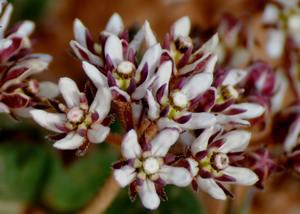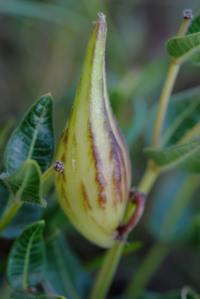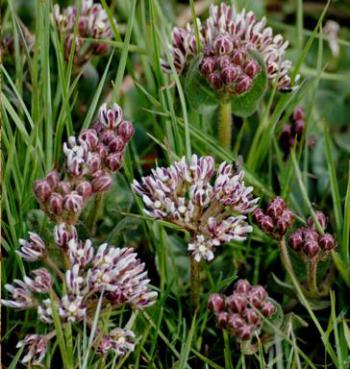Xysmalobium pedifoetidum
Xysmalobium pedifoetidum Bester & Nicholas
Family: Apocynaceae
Common names: northern red-flowered cartwheel
Introduction
Despite the fact that Xysmalobium pedifoetidum is the most recently described member in its genus, it has been known by taxonomists for more than 50 years. This plant has been aptly named — literally, feet that smell — because, when in full flower, one may probably smell it before seeing it!

Description
Description
Xysmalobium pedifoetidum plants are perennial herbs that die back in winter and resprout annually from a deep-seated tuber which is fleshy, cylindrical and elongated. The stems are mostly adpressed on the soil, spreading horizontally (up to 340mm long and form a plant with a diameter of ±500mm) with the inflorescences at the ends of stems held erect to display the umbel of aggregated flowers.

All parts of the plant contain white sticky sap that is extremely bitter. The leaves are bright green, broadly oval with a square base and short stalks, somewhat hairy and thick textured and with distinct venation.
The flowers are aggregated in heads (umbels) at the end of the stems, pink to maroon on the outside (or various shades thereof) and off-white to cream on the inside; the corona lobes are usually dark maroon. Plants flower from November to January and, if pollinated, produce fruit ± a month after flowering. The fruit is a follicle, usually single and ±75mm long, with pale purple-maroon longitudinal stripes or blotches on a green background. For examples of follicles, see Stenostelma umbelluliferum and Pentarrhinum insipidum.

The fruit ripens within a month or so and the seed is distributed by the wind which blows them away. It has not been established if seeds germinate immediately, but is presumed that they stay dormant until the next season.
Conservation Status
Status
Currently this species is without a threat status, as it has not yet been assessed. The known populations seem to be quite healthy and land use and available habitat will probably largely determine its Red List status.

Distribution and habitat
Distribution description
The northern red-flowered cartwheel grows in open grassland with quartzite outcrops on gently rolling slopes or plains at reasonably high altitudes (1800-2050m) in Mpumalanga and KwaZulu-Natal . The plants occur in areas with frost and even snow in winter with high rainfall and moderate temperatures in summer.

The soil is well-drained to moist or damp, gravelly to humic or black clays, with a high organic content. These areas are usually burnt annually and plants grow in full sun.
Derivation of name and historical aspects
History
The generic name is derived from the two Greek words, xusma = fragment, and lobos = division, which refer to the minute division of the corona lobe of the first described species, albeit not very obvious in this species.

The flowers have a sourish scent reminiscent of fermenting fruit at first and then of malodorous feet which led to the choice of name that literally means the feet=pedi that stink=foetidum.
Bester & Condy (2011) give the interesting history of how this species was eventually described half a century after it was first recognised as a new plant.
The genus Xysmalobium consists of about 40 species and is endemic to Africa with ±22 species found in southern Africa. Within this genus, there are a number of different groups that vary from small to robust herbs that are very variable in appearance. The vernacular name cartwheels includes species from both Asclepias ( see A . albens ) and Xysmalobium. Species similar to X . pedifoetidum include X . aceratoides, X . involucratum and X . parviflorum.
Ecology
Ecology
This species occurs in areas with very low winter temperatures — frost and snow are not uncommon. Plants have adapted to the environment by having a perennial life with a very specific seasonal cycle. Very little work has been done on the phenology (times of different stages in the life cycle of the plant), but like most other Xysmalobium species (e.g. X. involucratum and X. undulatum ), plants are long-lived.
Aerial stems grow from minute adventitious buds at the base of old flowering stems in spring. The stems grow throughout the season and die back in autumn. Plants thus survive underground as deep-seated tubers, which will sprout again when temperatures rise in early summer.
It has been observed that many orders of insects visit the flower heads where the flowers all open at more or less the same time. Various species of flies were observed to be attracted to the flowers — presumably by the putrid smell. Various ants and other insects were also attracted to the flowers, possibly scouting for nectar.
The rate of successful pollination is low. In Xysmalobium the production of fruit compared to the number of flowers per plant per season is very low, but the number of seed in a single fruit higher (usually at least 40 seeds per fruit).
Uses
Use
As a recently and newly described species (2011,) almost no information exists on any of the biological aspects of the plant. Despite inquiring from a few local inhabitants in its natural distribution area, it has not yet been established if there are any traditional uses for these plants.
In one of the provincial reserves where it co-exists with numerous introduced blesbok, it has been noticed that the plants are grazed frequently (possibly only accidentally).
Growing Xysmalobium pedifoetidum
Grow
As far as could be established this species, and the genus at large, has never been cultivated. As with many members of this family that have a deep rootstock, it is quite difficult to cultivate. The best would be to get fresh seed and, in planting it, try to simulate similar growing conditions as in the wild (low winter and moderate summer temperature, humic soil composition and abundant water in summer). Because of the development of a deep-seated tuber, these plants may present a challenge to those who like growing curiosity plants.
Plants form a round mat and are quite attractive when in full flower, but due to the short flowering time, it will possibly remain uncultivated (except for those that take up the challenge to try it!). In the garden, one could try to establish plants to act as a ground cover in summer.

Like most milkweeds, this species is also prone to attacks by aphids, lice and red spider mites. For more possible problem pests, see notes under Pachycarpus schinzianus .
References
- Bester, S.P., Nicholas, A. & Condy, G. 2011. Xysmalobium pedifoetidum . Flowering Plants of Africa 62: 100-109.
- Langley, R.W. 1980. Taxonomic studies in the Asclepiadeae with particular reference to Xysmalobium R.Br. in southern Africa . M.Sc. thesis. University of Natal, Durban.
- Leistner, O.A. (ed.). 2000. Seeds plants of southern Africa: families and genera. Strelitzia 10. National Botanical Institute, Pretoria.
- Pooley, E. 2005. A field guide to wild flowers of KwaZulu-Natal and the Eastern Region. Natal Flora Publication Trust, Durban.
Credits
S. P. Bester
National Herbarium (PRE)
July 2013
Plant Attributes:
Plant Type: Perennial
SA Distribution: KwaZulu-Natal, Mpumalanga
Soil type: Loam
Flowering season: Spring, Early Summer
PH:
Flower colour: White, Pink, Cream
Aspect: Full Sun
Gardening skill: Challenging
Special Features:
Horticultural zones








Rate this article
Article well written and informative
Rate this plant
Is this an interesting plant?
Login to add your Comment
Back to topNot registered yet? Click here to register.